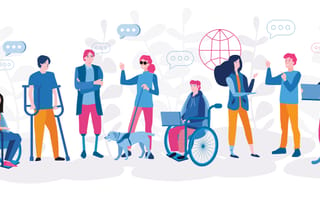Imagine trying to navigate the internet without being able to see the screen, hear audio or use a traditional mouse. For millions of people living with disabilities, this isn’t hypothetical. Everyday tasks like checking their email or buying an airplane ticket can be significantly harder to do because of how websites are designed. Luckily, as the internet has matured, the creation of web accessibility guidelines has made digital content more accommodating, allowing more people to effectively use the internet.
What is Web Accessibility?
Web accessibility is a set of standards and guidelines that ensure all people, regardless of abilities, can easily use and navigate digital interfaces, applications, products and services.
How Do People With Disabilities Navigate the Web?
People with disabilities use a variety of tools and strategies to navigate the web, depending on their specific needs. Because needs vary widely — and sometimes even conflict — it’s important to design websites that work with a wide range of assistive tools and remain usable across different contexts, even if that means going beyond basic accessibility requirements. Below are some of the most common ways individuals with disabilities access the web.
Screen Readers
Screen readers are helpful for visually impaired users. The programs pull the necessary information from pages’ HTML, such as titles and alt text labels, and convert the content into spoken words with speech synthesis.
Screen Magnifers
Screen magnifiers are software tools that increase the size of text and images on screen, making it easier for individuals with low or narrow vision.
Braille Displays
These devices take input from screen readers and translate it into braille, which is communicated to the user’s fingertips through a row of rounded pins that are mechanically raised and lowered.
Speech Recognition Software
Speech recognition software translates spoken words into text and executes commands based on user input.
Why Web Accessibility Matters
Design choices, whether intentional or not, determine who can benefit from tech products and who can’t. Every button placement, color contrast, font size and interactive elements sends a message about who was considered during the design process and who wasn’t. When accessibility is overlooked, it may cause minor inconveniences for some — but for others, it can mean total exclusion from essential services and information.
By overlooking accessibility, developers and organizations create barriers that affect people with disabilities, older adults, individuals with temporary impairments and even people in limiting environments, such as weak cellular service or bright sunlight. Accessible web development acknowledges a wide range of human disabilities and circumstances, and creates a space where everyone has equal access.
Accessibility Standards Explained
The World Wide Web Consortium (W3C) has been spearheading the development of accessibility guidelines for the internet since 1994. Its Web Content Accessibility Guidelines (WCAG) are designed to ensure websites are high-quality, interoperable and accessible to all users, regardless of their abilities or the devices they use to navigate the web.
At their core, the guidelines provide specific recommendations for web development languages like HTML, XHTML, CSS and JavaScript that developers should follow when designing web pages. Some of its specific standards include using proper HTML headings, enabling full keyboard navigation, maintaining left-to-right text direction, providing text alternatives for images and meeting minimum color contrast requirements.
The Americans with Disabilities Act (ADA) is another big proponent of web accessibility, and requires that digital content from government agencies and businesses be accessible to people with disabilities. The ADA does provide specific standards of its own, but recommends that government websites follow WCAG standards.
The Business Case for Accessibility
Web accessibility is a legal requirement for all businesses under the Americans with Disabilities Act (ADA), and several major companies like Domino’s Target and Netflix have faced legal consequences for failing to fulfill these requirements. But investing in web accessibility shouldn’t just be about compliance — it’s also a smart business decision. Providing a more usable site opens the door to a much broader customer base, improves overall user experience and can foster long-term brand loyalty by demonstrating a commitment to inclusion.
Accessibility also supports better performance in search engines. Following best practices, such as using semantic HTML, proper heading structures and descriptive link labels not only helps assistive technology interpret the web page, but it improves SEO, making content more discoverable through organic search, too.
In short: Accessibility can drive growth, enhance brand reputation and improve usability in ways that benefit all users, while also ensuring businesses stay on the right side of the law.
Frequently Asked Questions
Why is web accessibility important?
Web accessibility helps to ensure that people with disabilities can access and use digital interfaces. Without it, they may be excluded from essential services and information.
What are common tools people with disabilities use to access the web?
Users may rely on screen readers, screen magnifiers, braille displays or speech recognition software to navigate websites.
What is WCAG and who created it?
The WCAG, or Web Content Accessibility Guidelines, were developed by the World Wide Web Consortium (W3C) to establish consistent standards for making digital interfaces accessible across different devices and user needs.
What are some examples of accessibility standards?
Common examples of accessibility standards include using HTML headers, allowing keyboard navigation, ensuring color contrast and providing alt text for images.




